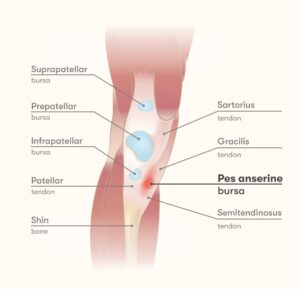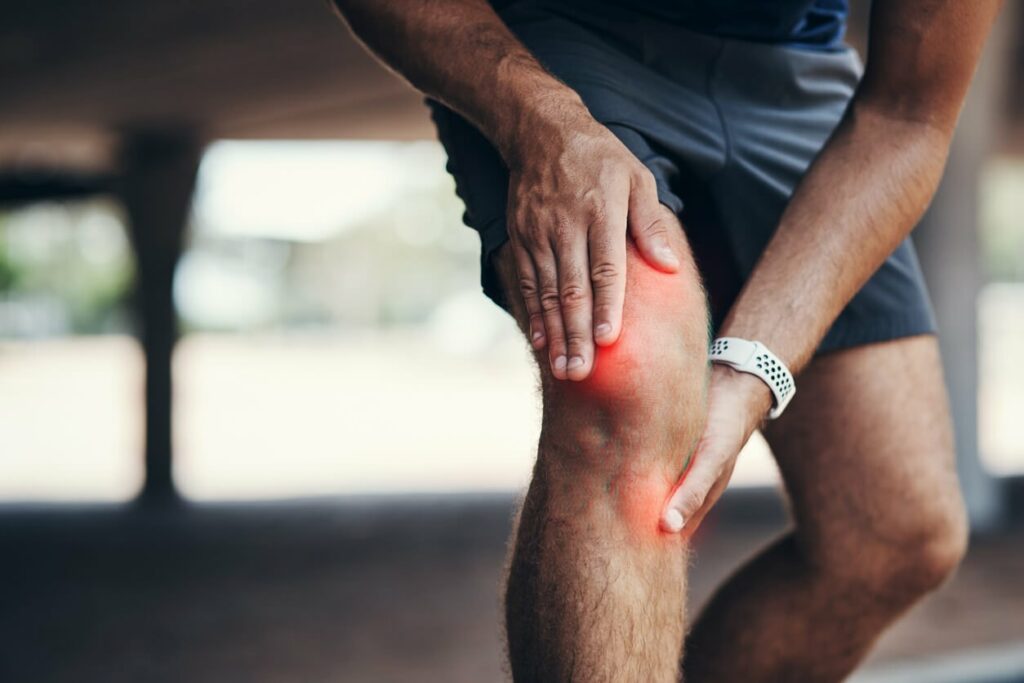If you are suffering from pes anserine bursitis, you may be wondering what the best treatment options are. This guide will provide you with information on the most effective ways to manage your condition and relieve your pain. There are many different treatments that can be helpful for pes anserine bursitis, and it is important to find the right one for you. In this guide, we will discuss a variety of treatment options, as well as their benefits and drawbacks.
Contents
What is Pes Anserine Bursitis?

Pes Anserine Bursitis is a condition that occurs when the pes anserine bursa becomes inflamed. The pes anserine bursa is a small fluid-filled sac located near the shinbone, and it helps to reduce friction between muscles and tendons in this area. It is usually caused by repetitive movements, like running or climbing stairs, and it can be very painful.
Repetitive stress and strain on the pes anserine insertion are the usual causes of pes anserine bursitis. The majority of the time, this happens to runners who have abruptly upped their training intensity, but it can also happen to other athletes as an overuse issue. Occasionally, a direct impact on the inside of your knee can cause pes anserine soreness. You may also see a few signs and symptoms that can help you spot the problem early on. These include pain, swelling and stiffness around your knee, as well as a feeling of tightness in your leg.
Thankfully, there are some effective ways to manage pes anserine bursitis before it gets worse.
How Is Pes Anserine Diagnosed?
Pes anserine bursitis is often diagnosed based on the history of your symptoms and a physical exam. Imaging tests like x-rays or MRIs may be ordered to confirm the diagnosis but are not always necessary.
The most important sign that your pes anserine is involved is when you experience pain on the inside of your knee towards the back. The most common symptom of pes anserine bursitis is pain on the inside of your knee joint when you’re running or walking, especially up hills.
Pes anserine bursitis pain usually comes on gradually and can be difficult to tell apart from other conditions like IT band syndrome, chondromalacia patellar, or medial meniscus tears. As the condition progresses you may start to notice pain on the inside of your knee when you’re sitting with your leg bent, such as when riding a bicycle or even lying in bed at night.
If you suspect that you have pes anserine bursitis it is important to see your doctor as soon as possible. To get the correct treatment for pes anserine bursitis get tested early.
Treatment For Pes Anserine Bursitis
 With proper diagnosis pes anserine bursitis can be cured in a variety of methods. If identified in the early stages, there are several conservative treatment options which may address your symptoms. These include certain types of physical therapy, ice or heat use and anti-inflammatory medications. Let us discuss the different types of options that a physiotherapist might use to treat this condition.
With proper diagnosis pes anserine bursitis can be cured in a variety of methods. If identified in the early stages, there are several conservative treatment options which may address your symptoms. These include certain types of physical therapy, ice or heat use and anti-inflammatory medications. Let us discuss the different types of options that a physiotherapist might use to treat this condition.
Physical Therapy
The primary goal of physical therapy for pes anserine bursitis is to help reduce swelling, ease pain and improve the range of motion and mobility in the affected structures. This includes working with your muscles, soft tissues and joints through a variety of methods.
Ice Packs
One common method for treating pes anserine bursitis is to use ice packs, which can help reduce inflammation. Applying ice to the area of injury will also help reduce pain and promote healing by restricting blood flow to the injured tissues. This can help minimize further damage as well.
Heat Patches
Another treatment option is using heat on your injured tissues. This can help relax the muscles and joints, which can improve the range of motion as well as reduce pain.
Exercises
There are also a variety of exercises that your physiotherapist might recommend to help treat pes anserine bursitis. These include stretching exercises to promote better flexibility, joint mobilization to improve mobility in the affected structures, strengthening exercises to address muscle imbalances and balance training to improve stability.
Anti-Inflammatory Injections
Another option is using anti-inflammatory medications, such as ibuprofen or naproxen, which can help control pain and reduce swelling of the bursa. Your physiotherapist may also recommend that you wear an elastic bandage or compression garment over your injured area to minimize any swelling and discomfort.
Ultimately, the best approach for treating pes anserine bursitis will vary depending on each individual case. Depending on your symptoms and medical history, your physiotherapist may recommend a combination of these treatment methods in order to help address your condition as effectively as possible.
If you are experiencing symptoms of pes anserine bursitis, book a consultation with a physiotherapist today. They can assess your injuries, provide you with the right treatment options and get you back on the road to recovery as quickly as possible.
Best Physiotherapy Exercises To Cure Pes Anserine Bursitis

Some exercises to cure pes anserine are:
Glute Bridge
Lie flat on your stomach. With feet shoulder-width apart, slowly push up until you have formed a straight line from shoulders to knees. Bring your hips forward and hold for about 5 seconds before slowly returning to the starting position. Do this exercise for 15 repetitions and complete 3 sets daily.
Wall Squat
Stand with back against wall, feet shoulder-width apart. Slowly lower yourself, bending your knees until your kneecaps are directly above your ankles. Hold this position for 5 seconds then stand up without raising your buttocks off the wall and repeat 10 to 15 times daily.
Calf Raises
Stand with both feet on a step or raised platform so that the heels are off the edge. Slowly lower yourself, bending your knees until you feel a stretch or tension in your calves. Hold for about 5 seconds and slowly raise yourself back to starting position and repeat 10 times daily.
Standing Calf Stretch
Stand at arm’s length from the wall with one leg forward while the knee of the other leg is bent and foot is flat on the ground. Using your elbow, gently apply pressure to the stretched calf muscles until you feel a stretch or tension in them. Hold for about 10 seconds before returning to the starting position and repeat 10 times daily.
Static Quadriceps Stretch
Stand upright with one hand against a wall for balance if required. Bend one knee slightly and grab the ankle with the other hand. Gently pull your heel towards your buttocks until you feel a stretch in the front of your thigh. Hold for about 10 seconds before returning to the starting position and repeat 10 times daily.
Hamstring Stretch
Lie on your back with one leg straight out and the other bent up by your buttocks. Grab the thigh of the bent leg and pull it gently towards you. Do this until you feel a stretch in the back of your legs. Hold for about 10 seconds before returning to the starting position and repeat 10 times daily on each leg.
These exercises can be done without equipment, but if you do not feel confident to do them by yourself then it is better to consult with a physiotherapist.
How Long Does It Take To Recover?
The recovery time for pes anserine bursitis greatly depends on the severity of the condition. In general, a mild case of pes anserine bursitis can take from 7 to 10 days to heal. However, a more severe case may take several months to recover completely, or it might not fully heal at all.
Conclusion
In conclusion, pes anserine bursitis is a condition that can be quite painful and debilitating. However, with the right treatment plan, it is possible to make a full recovery. Some of the most effective methods for treating pes anserine bursitis include rest, physical therapy, cold compresses, and pain medication. If these treatments do not provide sufficient relief from your symptoms, then you may need to consider surgery. However, before opting for this type of treatment, it is always best to consult with your doctor first. Whether you are suffering from mild or severe pes anserine bursitis, there is hope for a full recovery. This is possible provided you work closely with your medical team and follow their recommended treatment plan.
Physical Therapy help patients recover from pain. If you’re experiencing Back pain, Shoulder pain, Knee pain, Neck pain, Elbow pain, Hip pain, or Arthritis pain, a physical therapist at MantraCare can help: Book a physiotherapy session.


